Advanced Investment Management Project: Portfolio Analysis, BANK5030
VerifiedAdded on 2022/09/14
|13
|2827
|10
Project
AI Summary
This project delves into the intricacies of advanced investment management, beginning with detailed calculations and analysis of portfolio returns, standard deviations, and covariances for assets X and Y. The analysis extends to constructing various portfolios with different weightings in the two assets, calculating their expected returns and standard deviations, and plotting these relationships to identify the efficient frontier. The project then proceeds to determine the global minimum-variance portfolio. The discussion section evaluates the advice of two financial professionals, Anne and Paul, regarding investment strategies and diversification. The project concludes with an examination of Exchange Traded Funds (ETFs), assessing their significance as product innovations and their impact on market efficiency, highlighting their role in providing investors with a diversified and accessible investment tool, and assessing their impact on market efficiency and investor strategies.
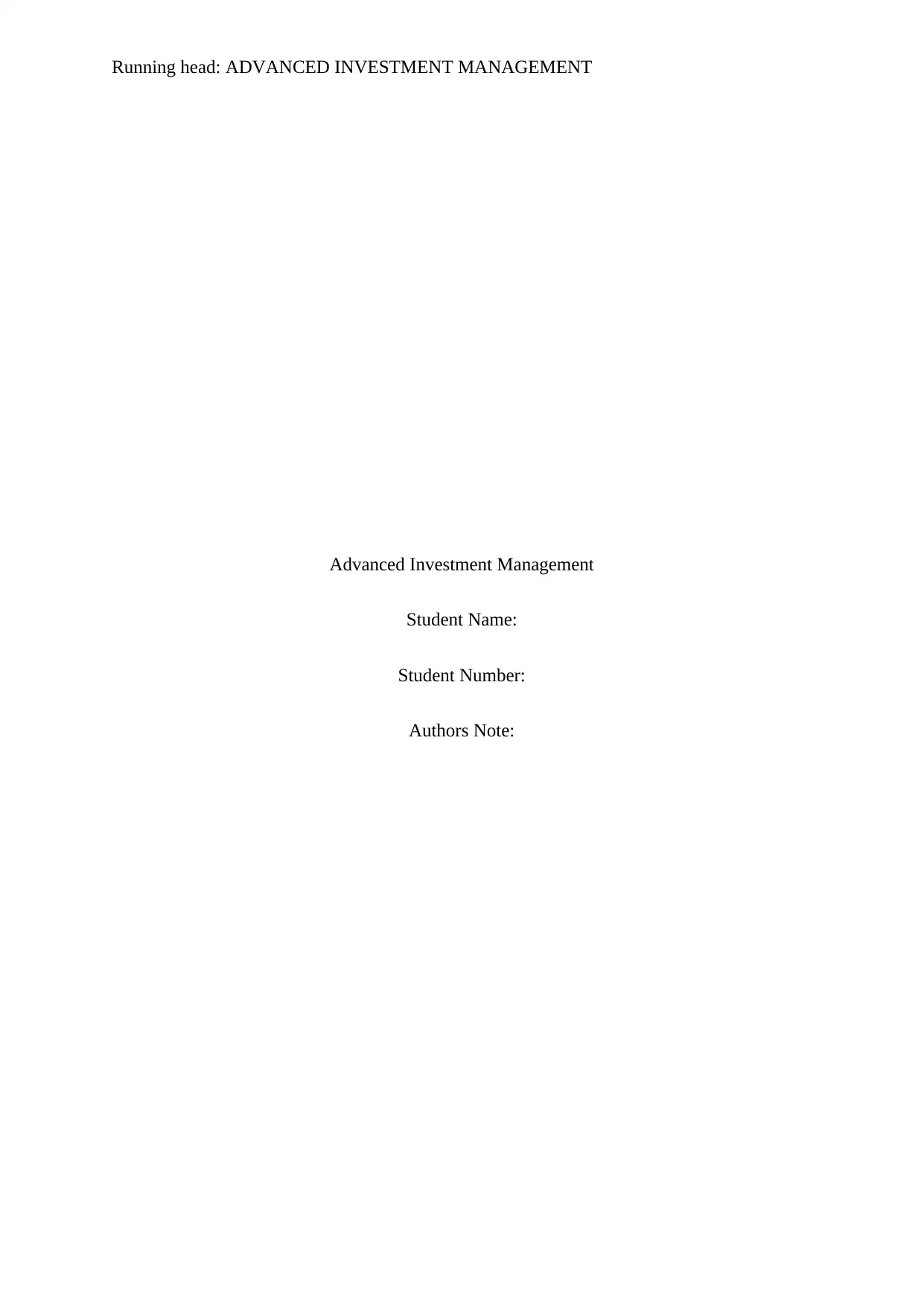
Running head: ADVANCED INVESTMENT MANAGEMENT
Advanced Investment Management
Student Name:
Student Number:
Authors Note:
Advanced Investment Management
Student Name:
Student Number:
Authors Note:
Paraphrase This Document
Need a fresh take? Get an instant paraphrase of this document with our AI Paraphraser
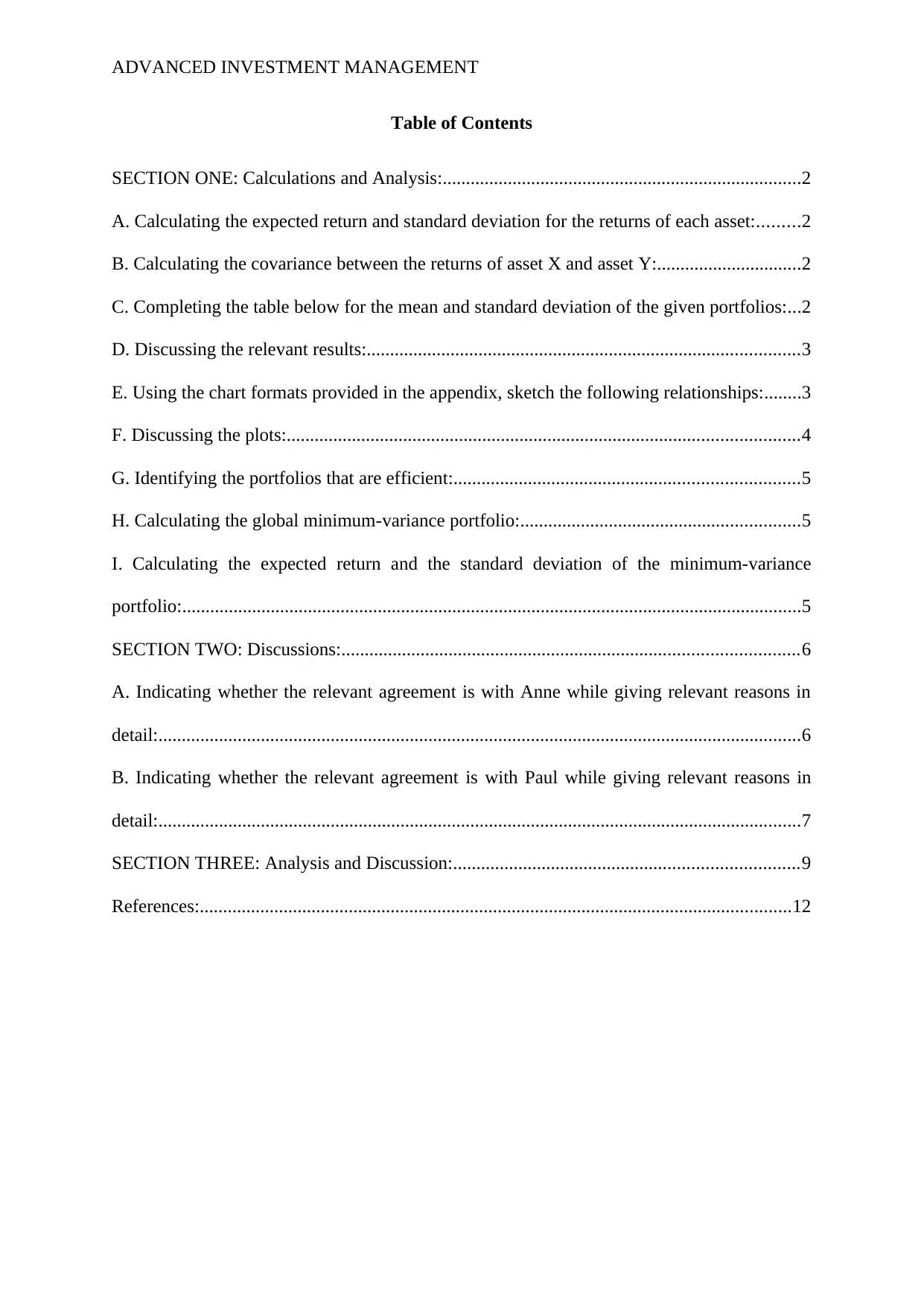
ADVANCED INVESTMENT MANAGEMENT
Table of Contents
SECTION ONE: Calculations and Analysis:.............................................................................2
A. Calculating the expected return and standard deviation for the returns of each asset:.........2
B. Calculating the covariance between the returns of asset X and asset Y:...............................2
C. Completing the table below for the mean and standard deviation of the given portfolios:...2
D. Discussing the relevant results:.............................................................................................3
E. Using the chart formats provided in the appendix, sketch the following relationships:........3
F. Discussing the plots:..............................................................................................................4
G. Identifying the portfolios that are efficient:..........................................................................5
H. Calculating the global minimum-variance portfolio:............................................................5
I. Calculating the expected return and the standard deviation of the minimum-variance
portfolio:.....................................................................................................................................5
SECTION TWO: Discussions:..................................................................................................6
A. Indicating whether the relevant agreement is with Anne while giving relevant reasons in
detail:..........................................................................................................................................6
B. Indicating whether the relevant agreement is with Paul while giving relevant reasons in
detail:..........................................................................................................................................7
SECTION THREE: Analysis and Discussion:..........................................................................9
References:...............................................................................................................................12
Table of Contents
SECTION ONE: Calculations and Analysis:.............................................................................2
A. Calculating the expected return and standard deviation for the returns of each asset:.........2
B. Calculating the covariance between the returns of asset X and asset Y:...............................2
C. Completing the table below for the mean and standard deviation of the given portfolios:...2
D. Discussing the relevant results:.............................................................................................3
E. Using the chart formats provided in the appendix, sketch the following relationships:........3
F. Discussing the plots:..............................................................................................................4
G. Identifying the portfolios that are efficient:..........................................................................5
H. Calculating the global minimum-variance portfolio:............................................................5
I. Calculating the expected return and the standard deviation of the minimum-variance
portfolio:.....................................................................................................................................5
SECTION TWO: Discussions:..................................................................................................6
A. Indicating whether the relevant agreement is with Anne while giving relevant reasons in
detail:..........................................................................................................................................6
B. Indicating whether the relevant agreement is with Paul while giving relevant reasons in
detail:..........................................................................................................................................7
SECTION THREE: Analysis and Discussion:..........................................................................9
References:...............................................................................................................................12
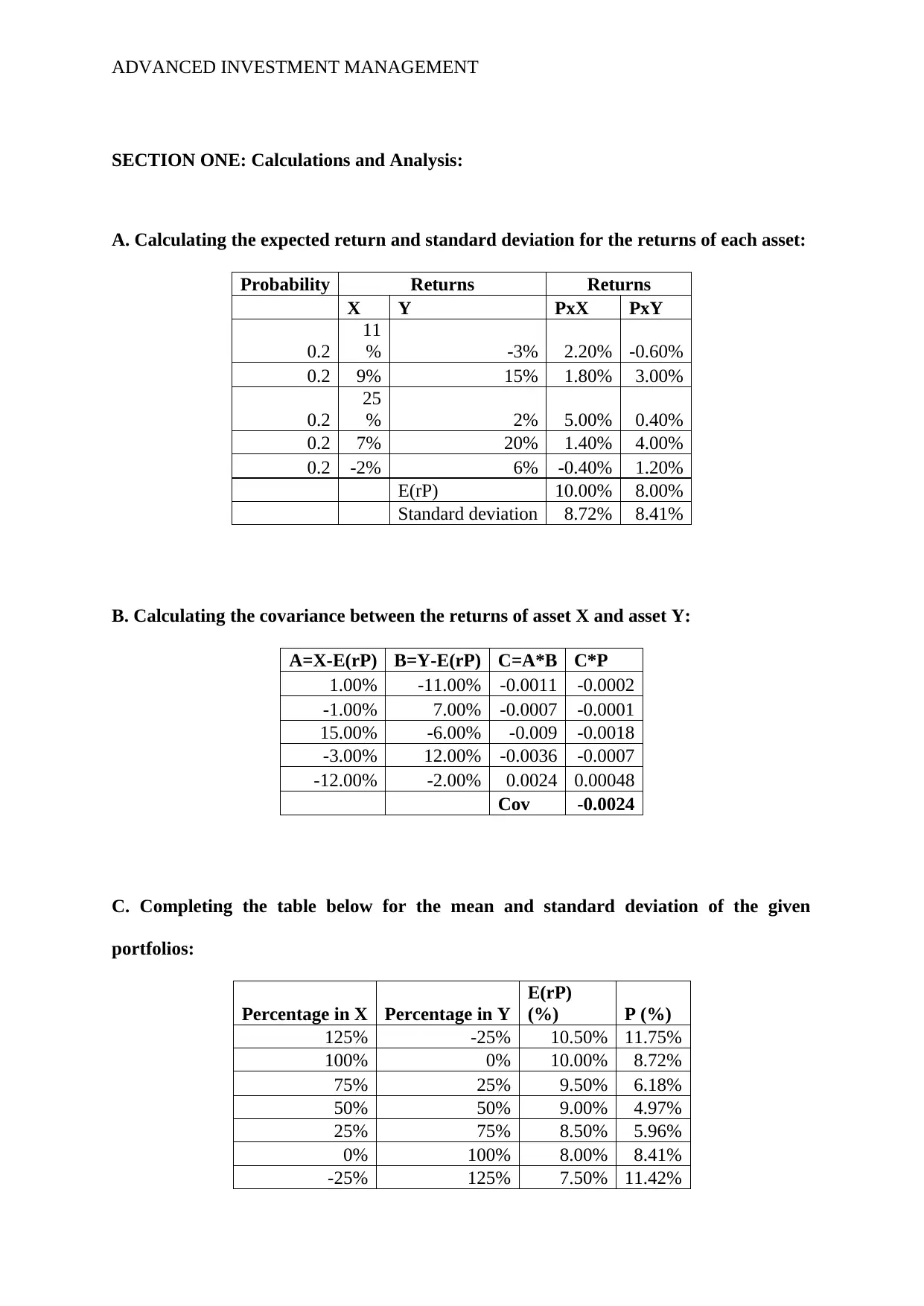
ADVANCED INVESTMENT MANAGEMENT
SECTION ONE: Calculations and Analysis:
A. Calculating the expected return and standard deviation for the returns of each asset:
Probability Returns Returns
X Y PxX PxY
0.2
11
% -3% 2.20% -0.60%
0.2 9% 15% 1.80% 3.00%
0.2
25
% 2% 5.00% 0.40%
0.2 7% 20% 1.40% 4.00%
0.2 -2% 6% -0.40% 1.20%
E(rP) 10.00% 8.00%
Standard deviation 8.72% 8.41%
B. Calculating the covariance between the returns of asset X and asset Y:
A=X-E(rP) B=Y-E(rP) C=A*B C*P
1.00% -11.00% -0.0011 -0.0002
-1.00% 7.00% -0.0007 -0.0001
15.00% -6.00% -0.009 -0.0018
-3.00% 12.00% -0.0036 -0.0007
-12.00% -2.00% 0.0024 0.00048
Cov -0.0024
C. Completing the table below for the mean and standard deviation of the given
portfolios:
Percentage in X Percentage in Y
E(rP)
(%) P (%)
125% -25% 10.50% 11.75%
100% 0% 10.00% 8.72%
75% 25% 9.50% 6.18%
50% 50% 9.00% 4.97%
25% 75% 8.50% 5.96%
0% 100% 8.00% 8.41%
-25% 125% 7.50% 11.42%
SECTION ONE: Calculations and Analysis:
A. Calculating the expected return and standard deviation for the returns of each asset:
Probability Returns Returns
X Y PxX PxY
0.2
11
% -3% 2.20% -0.60%
0.2 9% 15% 1.80% 3.00%
0.2
25
% 2% 5.00% 0.40%
0.2 7% 20% 1.40% 4.00%
0.2 -2% 6% -0.40% 1.20%
E(rP) 10.00% 8.00%
Standard deviation 8.72% 8.41%
B. Calculating the covariance between the returns of asset X and asset Y:
A=X-E(rP) B=Y-E(rP) C=A*B C*P
1.00% -11.00% -0.0011 -0.0002
-1.00% 7.00% -0.0007 -0.0001
15.00% -6.00% -0.009 -0.0018
-3.00% 12.00% -0.0036 -0.0007
-12.00% -2.00% 0.0024 0.00048
Cov -0.0024
C. Completing the table below for the mean and standard deviation of the given
portfolios:
Percentage in X Percentage in Y
E(rP)
(%) P (%)
125% -25% 10.50% 11.75%
100% 0% 10.00% 8.72%
75% 25% 9.50% 6.18%
50% 50% 9.00% 4.97%
25% 75% 8.50% 5.96%
0% 100% 8.00% 8.41%
-25% 125% 7.50% 11.42%
⊘ This is a preview!⊘
Do you want full access?
Subscribe today to unlock all pages.

Trusted by 1+ million students worldwide
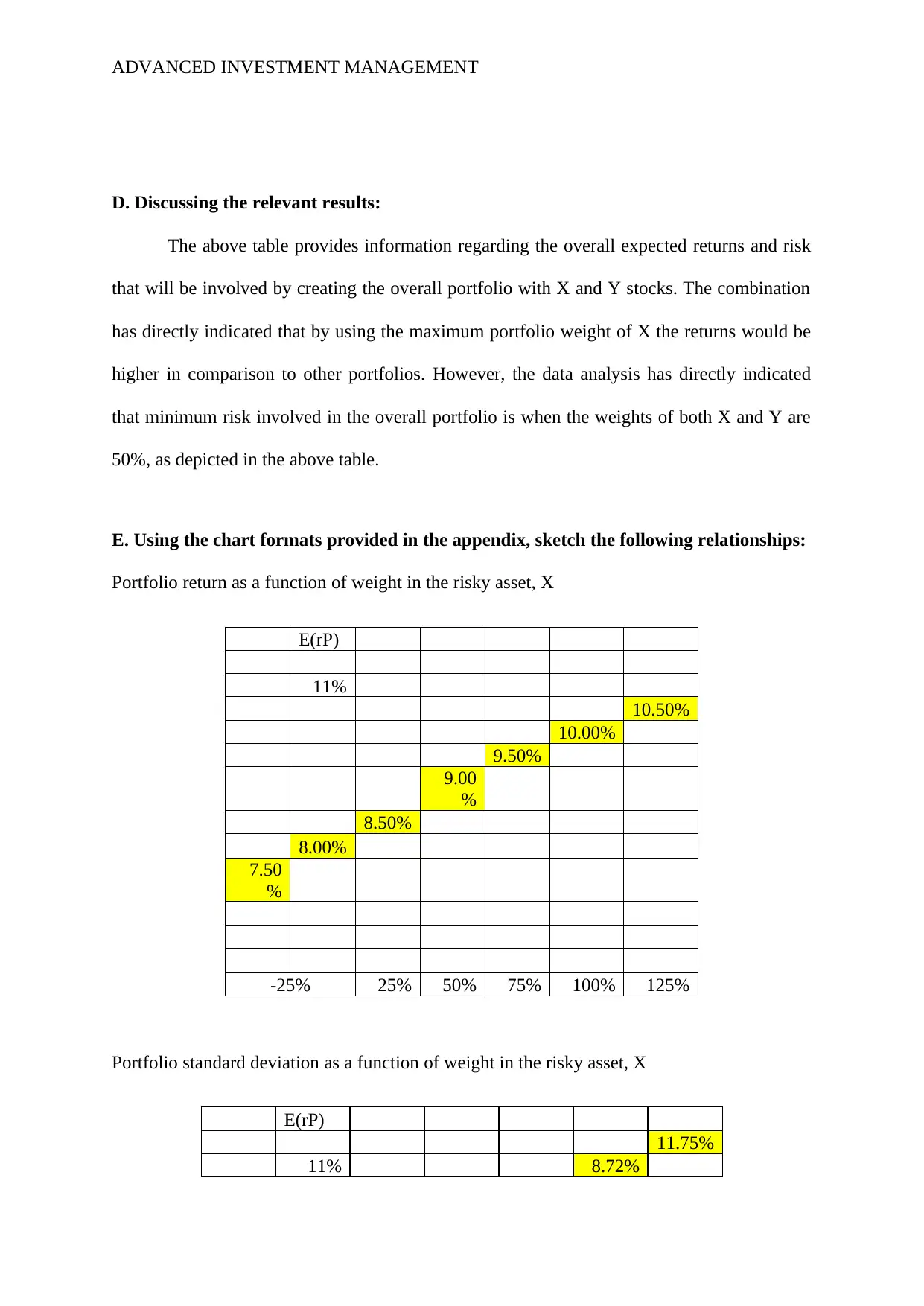
ADVANCED INVESTMENT MANAGEMENT
D. Discussing the relevant results:
The above table provides information regarding the overall expected returns and risk
that will be involved by creating the overall portfolio with X and Y stocks. The combination
has directly indicated that by using the maximum portfolio weight of X the returns would be
higher in comparison to other portfolios. However, the data analysis has directly indicated
that minimum risk involved in the overall portfolio is when the weights of both X and Y are
50%, as depicted in the above table.
E. Using the chart formats provided in the appendix, sketch the following relationships:
Portfolio return as a function of weight in the risky asset, X
E(rP)
11%
10.50%
10.00%
9.50%
9.00
%
8.50%
8.00%
7.50
%
-25% 25% 50% 75% 100% 125%
Portfolio standard deviation as a function of weight in the risky asset, X
E(rP)
11.75%
11% 8.72%
D. Discussing the relevant results:
The above table provides information regarding the overall expected returns and risk
that will be involved by creating the overall portfolio with X and Y stocks. The combination
has directly indicated that by using the maximum portfolio weight of X the returns would be
higher in comparison to other portfolios. However, the data analysis has directly indicated
that minimum risk involved in the overall portfolio is when the weights of both X and Y are
50%, as depicted in the above table.
E. Using the chart formats provided in the appendix, sketch the following relationships:
Portfolio return as a function of weight in the risky asset, X
E(rP)
11%
10.50%
10.00%
9.50%
9.00
%
8.50%
8.00%
7.50
%
-25% 25% 50% 75% 100% 125%
Portfolio standard deviation as a function of weight in the risky asset, X
E(rP)
11.75%
11% 8.72%
Paraphrase This Document
Need a fresh take? Get an instant paraphrase of this document with our AI Paraphraser
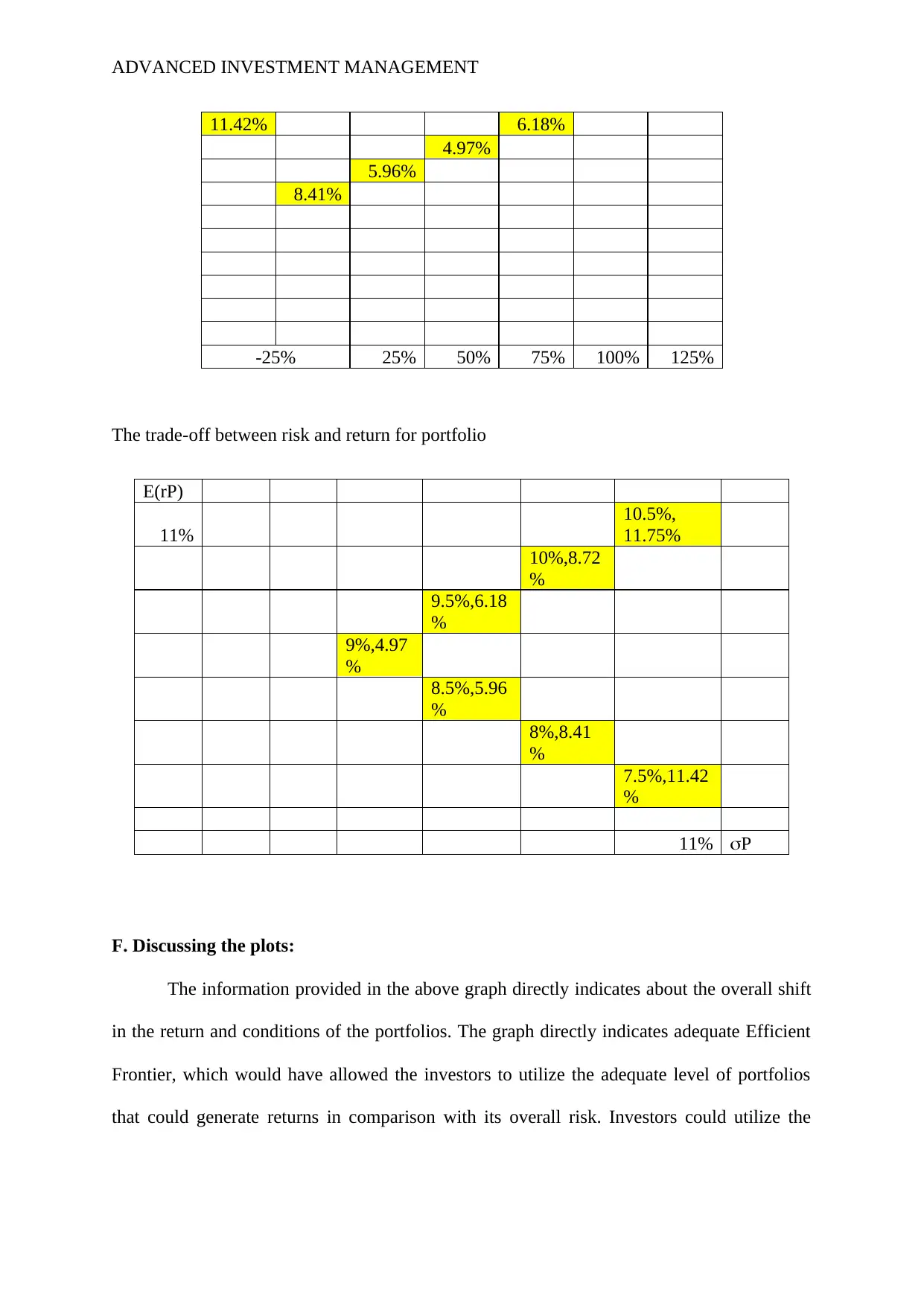
ADVANCED INVESTMENT MANAGEMENT
11.42% 6.18%
4.97%
5.96%
8.41%
-25% 25% 50% 75% 100% 125%
The trade-off between risk and return for portfolio
E(rP)
11%
10.5%,
11.75%
10%,8.72
%
9.5%,6.18
%
9%,4.97
%
8.5%,5.96
%
8%,8.41
%
7.5%,11.42
%
11% P
F. Discussing the plots:
The information provided in the above graph directly indicates about the overall shift
in the return and conditions of the portfolios. The graph directly indicates adequate Efficient
Frontier, which would have allowed the investors to utilize the adequate level of portfolios
that could generate returns in comparison with its overall risk. Investors could utilize the
11.42% 6.18%
4.97%
5.96%
8.41%
-25% 25% 50% 75% 100% 125%
The trade-off between risk and return for portfolio
E(rP)
11%
10.5%,
11.75%
10%,8.72
%
9.5%,6.18
%
9%,4.97
%
8.5%,5.96
%
8%,8.41
%
7.5%,11.42
%
11% P
F. Discussing the plots:
The information provided in the above graph directly indicates about the overall shift
in the return and conditions of the portfolios. The graph directly indicates adequate Efficient
Frontier, which would have allowed the investors to utilize the adequate level of portfolios
that could generate returns in comparison with its overall risk. Investors could utilize the
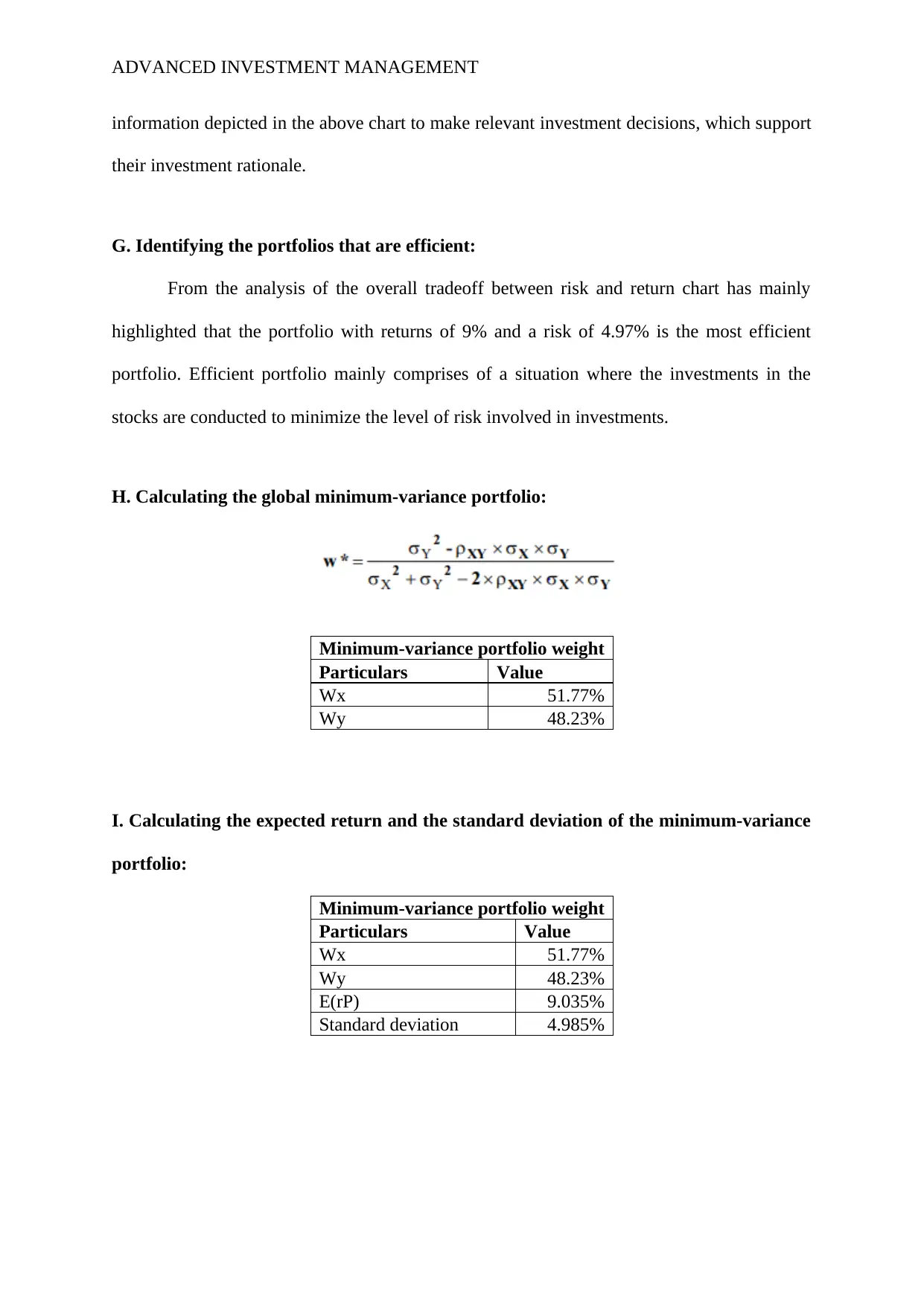
ADVANCED INVESTMENT MANAGEMENT
information depicted in the above chart to make relevant investment decisions, which support
their investment rationale.
G. Identifying the portfolios that are efficient:
From the analysis of the overall tradeoff between risk and return chart has mainly
highlighted that the portfolio with returns of 9% and a risk of 4.97% is the most efficient
portfolio. Efficient portfolio mainly comprises of a situation where the investments in the
stocks are conducted to minimize the level of risk involved in investments.
H. Calculating the global minimum-variance portfolio:
Minimum-variance portfolio weight
Particulars Value
Wx 51.77%
Wy 48.23%
I. Calculating the expected return and the standard deviation of the minimum-variance
portfolio:
Minimum-variance portfolio weight
Particulars Value
Wx 51.77%
Wy 48.23%
E(rP) 9.035%
Standard deviation 4.985%
information depicted in the above chart to make relevant investment decisions, which support
their investment rationale.
G. Identifying the portfolios that are efficient:
From the analysis of the overall tradeoff between risk and return chart has mainly
highlighted that the portfolio with returns of 9% and a risk of 4.97% is the most efficient
portfolio. Efficient portfolio mainly comprises of a situation where the investments in the
stocks are conducted to minimize the level of risk involved in investments.
H. Calculating the global minimum-variance portfolio:
Minimum-variance portfolio weight
Particulars Value
Wx 51.77%
Wy 48.23%
I. Calculating the expected return and the standard deviation of the minimum-variance
portfolio:
Minimum-variance portfolio weight
Particulars Value
Wx 51.77%
Wy 48.23%
E(rP) 9.035%
Standard deviation 4.985%
⊘ This is a preview!⊘
Do you want full access?
Subscribe today to unlock all pages.

Trusted by 1+ million students worldwide
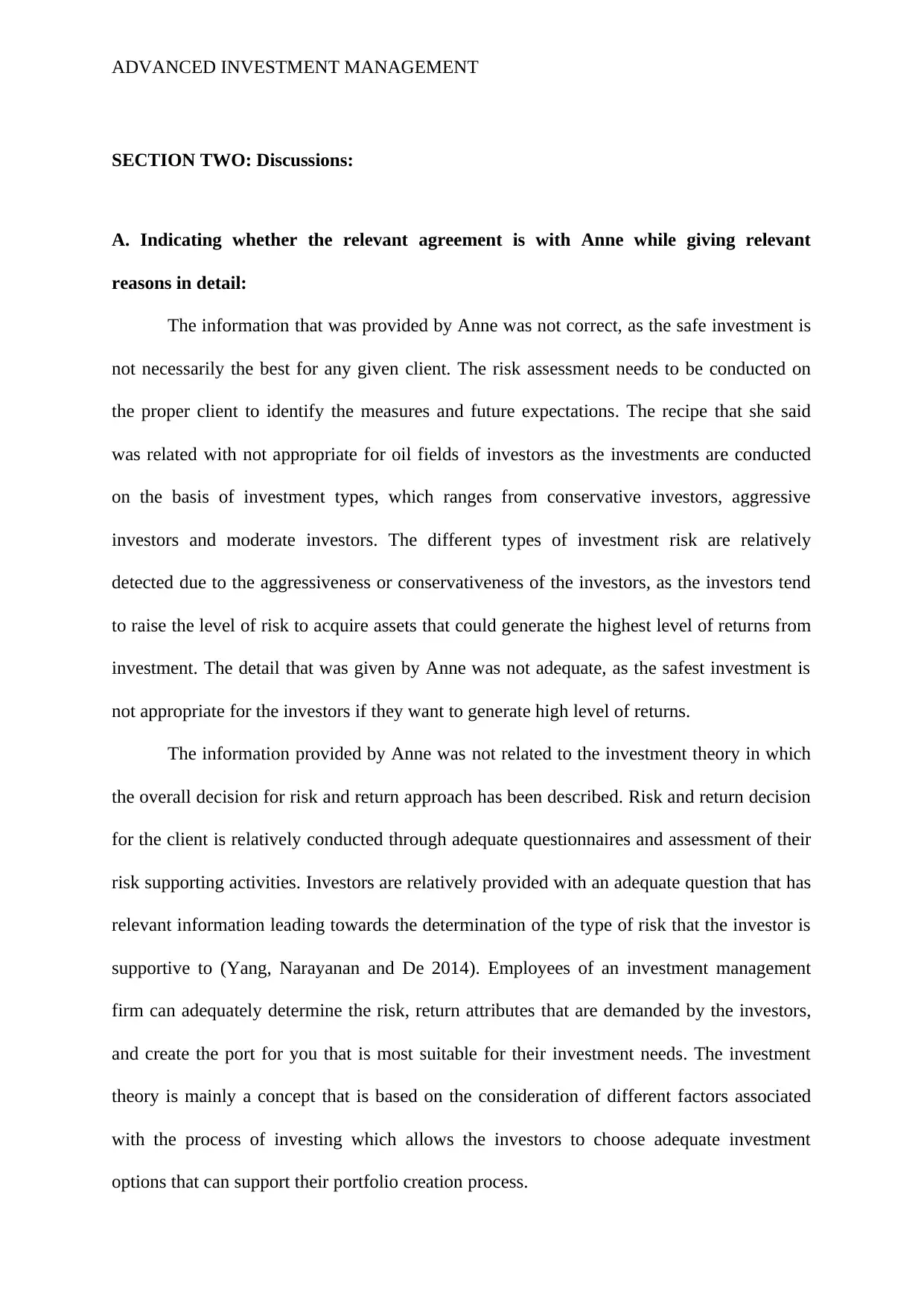
ADVANCED INVESTMENT MANAGEMENT
SECTION TWO: Discussions:
A. Indicating whether the relevant agreement is with Anne while giving relevant
reasons in detail:
The information that was provided by Anne was not correct, as the safe investment is
not necessarily the best for any given client. The risk assessment needs to be conducted on
the proper client to identify the measures and future expectations. The recipe that she said
was related with not appropriate for oil fields of investors as the investments are conducted
on the basis of investment types, which ranges from conservative investors, aggressive
investors and moderate investors. The different types of investment risk are relatively
detected due to the aggressiveness or conservativeness of the investors, as the investors tend
to raise the level of risk to acquire assets that could generate the highest level of returns from
investment. The detail that was given by Anne was not adequate, as the safest investment is
not appropriate for the investors if they want to generate high level of returns.
The information provided by Anne was not related to the investment theory in which
the overall decision for risk and return approach has been described. Risk and return decision
for the client is relatively conducted through adequate questionnaires and assessment of their
risk supporting activities. Investors are relatively provided with an adequate question that has
relevant information leading towards the determination of the type of risk that the investor is
supportive to (Yang, Narayanan and De 2014). Employees of an investment management
firm can adequately determine the risk, return attributes that are demanded by the investors,
and create the port for you that is most suitable for their investment needs. The investment
theory is mainly a concept that is based on the consideration of different factors associated
with the process of investing which allows the investors to choose adequate investment
options that can support their portfolio creation process.
SECTION TWO: Discussions:
A. Indicating whether the relevant agreement is with Anne while giving relevant
reasons in detail:
The information that was provided by Anne was not correct, as the safe investment is
not necessarily the best for any given client. The risk assessment needs to be conducted on
the proper client to identify the measures and future expectations. The recipe that she said
was related with not appropriate for oil fields of investors as the investments are conducted
on the basis of investment types, which ranges from conservative investors, aggressive
investors and moderate investors. The different types of investment risk are relatively
detected due to the aggressiveness or conservativeness of the investors, as the investors tend
to raise the level of risk to acquire assets that could generate the highest level of returns from
investment. The detail that was given by Anne was not adequate, as the safest investment is
not appropriate for the investors if they want to generate high level of returns.
The information provided by Anne was not related to the investment theory in which
the overall decision for risk and return approach has been described. Risk and return decision
for the client is relatively conducted through adequate questionnaires and assessment of their
risk supporting activities. Investors are relatively provided with an adequate question that has
relevant information leading towards the determination of the type of risk that the investor is
supportive to (Yang, Narayanan and De 2014). Employees of an investment management
firm can adequately determine the risk, return attributes that are demanded by the investors,
and create the port for you that is most suitable for their investment needs. The investment
theory is mainly a concept that is based on the consideration of different factors associated
with the process of investing which allows the investors to choose adequate investment
options that can support their portfolio creation process.
Paraphrase This Document
Need a fresh take? Get an instant paraphrase of this document with our AI Paraphraser
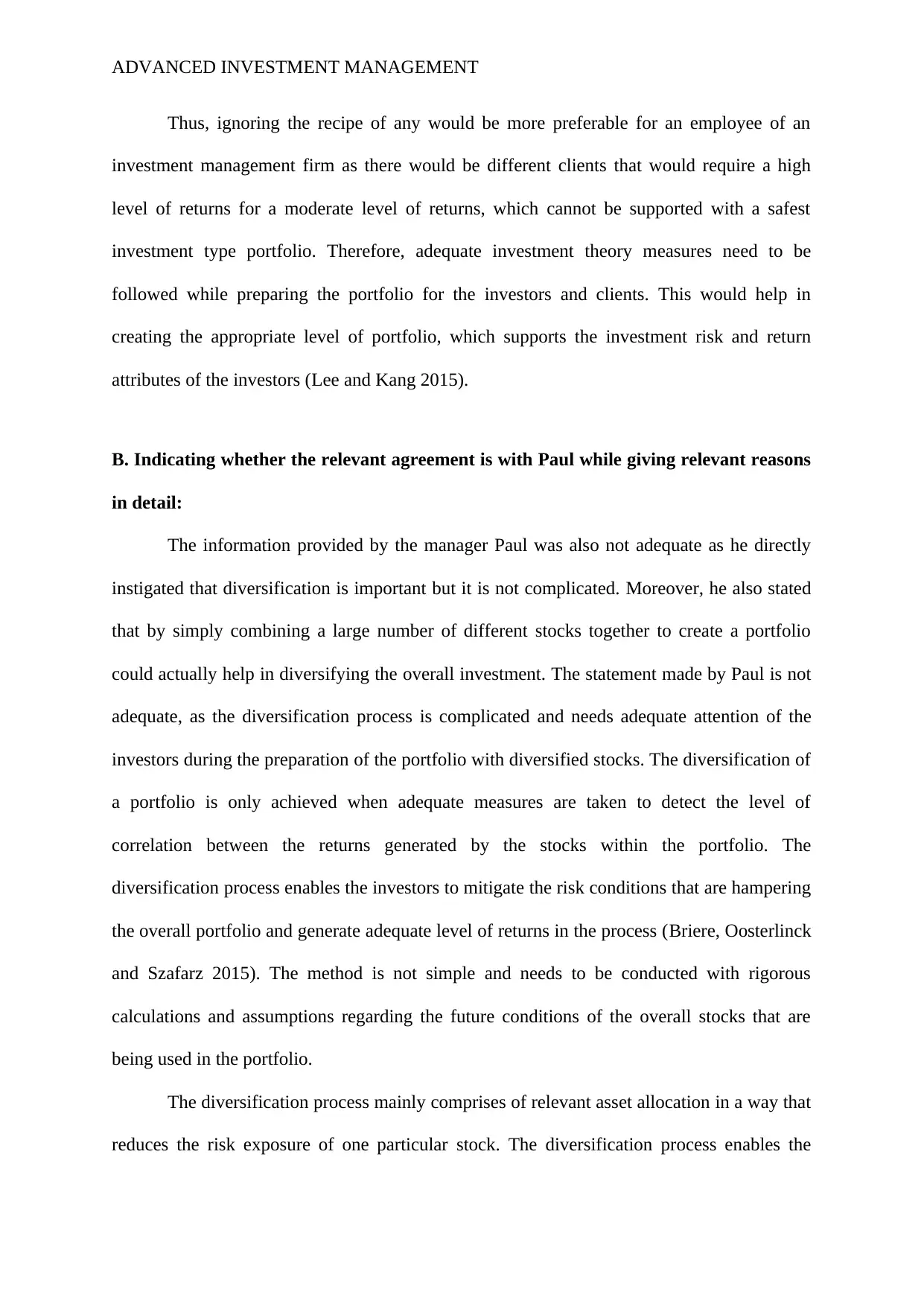
ADVANCED INVESTMENT MANAGEMENT
Thus, ignoring the recipe of any would be more preferable for an employee of an
investment management firm as there would be different clients that would require a high
level of returns for a moderate level of returns, which cannot be supported with a safest
investment type portfolio. Therefore, adequate investment theory measures need to be
followed while preparing the portfolio for the investors and clients. This would help in
creating the appropriate level of portfolio, which supports the investment risk and return
attributes of the investors (Lee and Kang 2015).
B. Indicating whether the relevant agreement is with Paul while giving relevant reasons
in detail:
The information provided by the manager Paul was also not adequate as he directly
instigated that diversification is important but it is not complicated. Moreover, he also stated
that by simply combining a large number of different stocks together to create a portfolio
could actually help in diversifying the overall investment. The statement made by Paul is not
adequate, as the diversification process is complicated and needs adequate attention of the
investors during the preparation of the portfolio with diversified stocks. The diversification of
a portfolio is only achieved when adequate measures are taken to detect the level of
correlation between the returns generated by the stocks within the portfolio. The
diversification process enables the investors to mitigate the risk conditions that are hampering
the overall portfolio and generate adequate level of returns in the process (Briere, Oosterlinck
and Szafarz 2015). The method is not simple and needs to be conducted with rigorous
calculations and assumptions regarding the future conditions of the overall stocks that are
being used in the portfolio.
The diversification process mainly comprises of relevant asset allocation in a way that
reduces the risk exposure of one particular stock. The diversification process enables the
Thus, ignoring the recipe of any would be more preferable for an employee of an
investment management firm as there would be different clients that would require a high
level of returns for a moderate level of returns, which cannot be supported with a safest
investment type portfolio. Therefore, adequate investment theory measures need to be
followed while preparing the portfolio for the investors and clients. This would help in
creating the appropriate level of portfolio, which supports the investment risk and return
attributes of the investors (Lee and Kang 2015).
B. Indicating whether the relevant agreement is with Paul while giving relevant reasons
in detail:
The information provided by the manager Paul was also not adequate as he directly
instigated that diversification is important but it is not complicated. Moreover, he also stated
that by simply combining a large number of different stocks together to create a portfolio
could actually help in diversifying the overall investment. The statement made by Paul is not
adequate, as the diversification process is complicated and needs adequate attention of the
investors during the preparation of the portfolio with diversified stocks. The diversification of
a portfolio is only achieved when adequate measures are taken to detect the level of
correlation between the returns generated by the stocks within the portfolio. The
diversification process enables the investors to mitigate the risk conditions that are hampering
the overall portfolio and generate adequate level of returns in the process (Briere, Oosterlinck
and Szafarz 2015). The method is not simple and needs to be conducted with rigorous
calculations and assumptions regarding the future conditions of the overall stocks that are
being used in the portfolio.
The diversification process mainly comprises of relevant asset allocation in a way that
reduces the risk exposure of one particular stock. The diversification process enables the
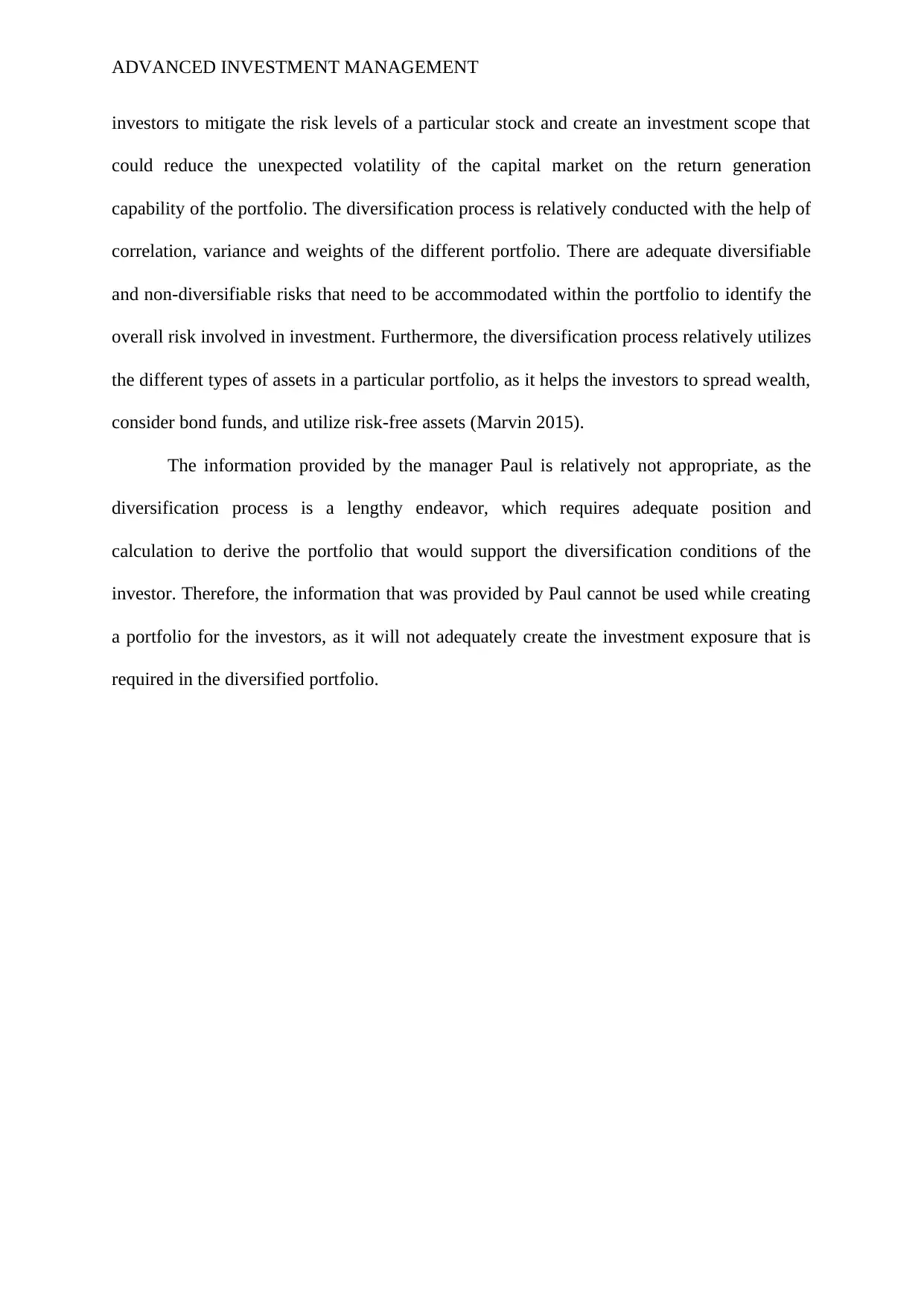
ADVANCED INVESTMENT MANAGEMENT
investors to mitigate the risk levels of a particular stock and create an investment scope that
could reduce the unexpected volatility of the capital market on the return generation
capability of the portfolio. The diversification process is relatively conducted with the help of
correlation, variance and weights of the different portfolio. There are adequate diversifiable
and non-diversifiable risks that need to be accommodated within the portfolio to identify the
overall risk involved in investment. Furthermore, the diversification process relatively utilizes
the different types of assets in a particular portfolio, as it helps the investors to spread wealth,
consider bond funds, and utilize risk-free assets (Marvin 2015).
The information provided by the manager Paul is relatively not appropriate, as the
diversification process is a lengthy endeavor, which requires adequate position and
calculation to derive the portfolio that would support the diversification conditions of the
investor. Therefore, the information that was provided by Paul cannot be used while creating
a portfolio for the investors, as it will not adequately create the investment exposure that is
required in the diversified portfolio.
investors to mitigate the risk levels of a particular stock and create an investment scope that
could reduce the unexpected volatility of the capital market on the return generation
capability of the portfolio. The diversification process is relatively conducted with the help of
correlation, variance and weights of the different portfolio. There are adequate diversifiable
and non-diversifiable risks that need to be accommodated within the portfolio to identify the
overall risk involved in investment. Furthermore, the diversification process relatively utilizes
the different types of assets in a particular portfolio, as it helps the investors to spread wealth,
consider bond funds, and utilize risk-free assets (Marvin 2015).
The information provided by the manager Paul is relatively not appropriate, as the
diversification process is a lengthy endeavor, which requires adequate position and
calculation to derive the portfolio that would support the diversification conditions of the
investor. Therefore, the information that was provided by Paul cannot be used while creating
a portfolio for the investors, as it will not adequately create the investment exposure that is
required in the diversified portfolio.
⊘ This is a preview!⊘
Do you want full access?
Subscribe today to unlock all pages.

Trusted by 1+ million students worldwide
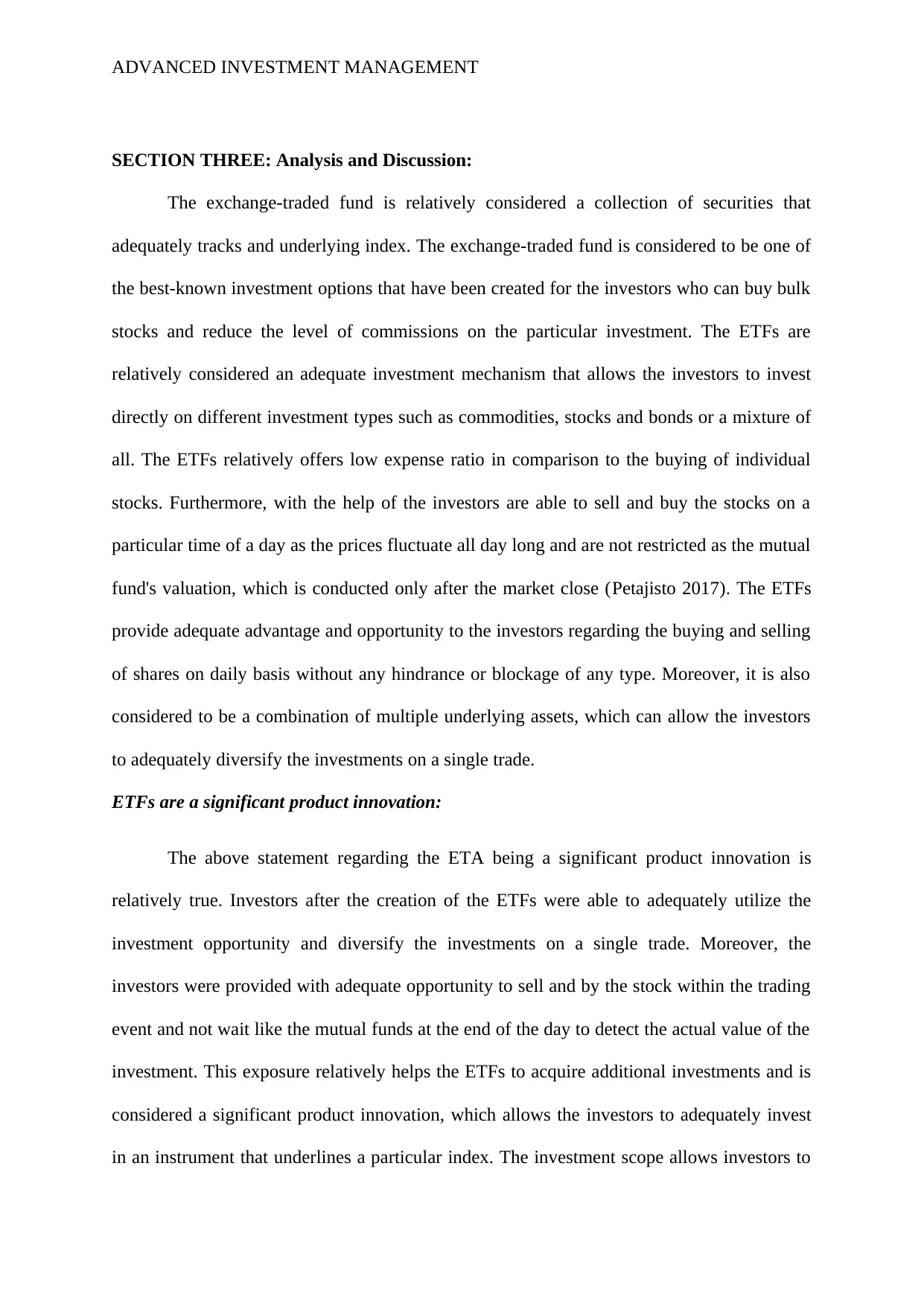
ADVANCED INVESTMENT MANAGEMENT
SECTION THREE: Analysis and Discussion:
The exchange-traded fund is relatively considered a collection of securities that
adequately tracks and underlying index. The exchange-traded fund is considered to be one of
the best-known investment options that have been created for the investors who can buy bulk
stocks and reduce the level of commissions on the particular investment. The ETFs are
relatively considered an adequate investment mechanism that allows the investors to invest
directly on different investment types such as commodities, stocks and bonds or a mixture of
all. The ETFs relatively offers low expense ratio in comparison to the buying of individual
stocks. Furthermore, with the help of the investors are able to sell and buy the stocks on a
particular time of a day as the prices fluctuate all day long and are not restricted as the mutual
fund's valuation, which is conducted only after the market close (Petajisto 2017). The ETFs
provide adequate advantage and opportunity to the investors regarding the buying and selling
of shares on daily basis without any hindrance or blockage of any type. Moreover, it is also
considered to be a combination of multiple underlying assets, which can allow the investors
to adequately diversify the investments on a single trade.
ETFs are a significant product innovation:
The above statement regarding the ETA being a significant product innovation is
relatively true. Investors after the creation of the ETFs were able to adequately utilize the
investment opportunity and diversify the investments on a single trade. Moreover, the
investors were provided with adequate opportunity to sell and by the stock within the trading
event and not wait like the mutual funds at the end of the day to detect the actual value of the
investment. This exposure relatively helps the ETFs to acquire additional investments and is
considered a significant product innovation, which allows the investors to adequately invest
in an instrument that underlines a particular index. The investment scope allows investors to
SECTION THREE: Analysis and Discussion:
The exchange-traded fund is relatively considered a collection of securities that
adequately tracks and underlying index. The exchange-traded fund is considered to be one of
the best-known investment options that have been created for the investors who can buy bulk
stocks and reduce the level of commissions on the particular investment. The ETFs are
relatively considered an adequate investment mechanism that allows the investors to invest
directly on different investment types such as commodities, stocks and bonds or a mixture of
all. The ETFs relatively offers low expense ratio in comparison to the buying of individual
stocks. Furthermore, with the help of the investors are able to sell and buy the stocks on a
particular time of a day as the prices fluctuate all day long and are not restricted as the mutual
fund's valuation, which is conducted only after the market close (Petajisto 2017). The ETFs
provide adequate advantage and opportunity to the investors regarding the buying and selling
of shares on daily basis without any hindrance or blockage of any type. Moreover, it is also
considered to be a combination of multiple underlying assets, which can allow the investors
to adequately diversify the investments on a single trade.
ETFs are a significant product innovation:
The above statement regarding the ETA being a significant product innovation is
relatively true. Investors after the creation of the ETFs were able to adequately utilize the
investment opportunity and diversify the investments on a single trade. Moreover, the
investors were provided with adequate opportunity to sell and by the stock within the trading
event and not wait like the mutual funds at the end of the day to detect the actual value of the
investment. This exposure relatively helps the ETFs to acquire additional investments and is
considered a significant product innovation, which allows the investors to adequately invest
in an instrument that underlines a particular index. The investment scope allows investors to
Paraphrase This Document
Need a fresh take? Get an instant paraphrase of this document with our AI Paraphraser
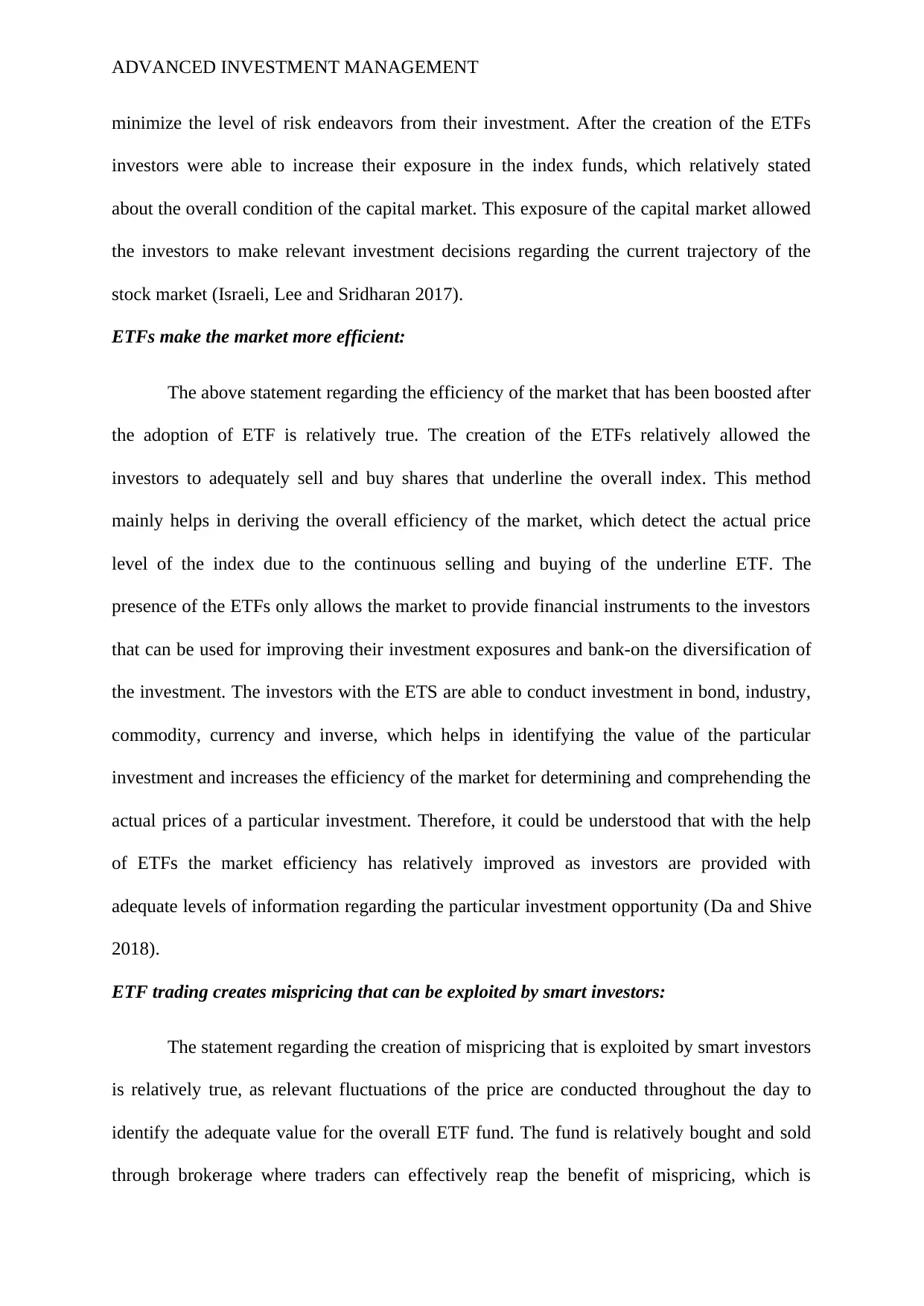
ADVANCED INVESTMENT MANAGEMENT
minimize the level of risk endeavors from their investment. After the creation of the ETFs
investors were able to increase their exposure in the index funds, which relatively stated
about the overall condition of the capital market. This exposure of the capital market allowed
the investors to make relevant investment decisions regarding the current trajectory of the
stock market (Israeli, Lee and Sridharan 2017).
ETFs make the market more efficient:
The above statement regarding the efficiency of the market that has been boosted after
the adoption of ETF is relatively true. The creation of the ETFs relatively allowed the
investors to adequately sell and buy shares that underline the overall index. This method
mainly helps in deriving the overall efficiency of the market, which detect the actual price
level of the index due to the continuous selling and buying of the underline ETF. The
presence of the ETFs only allows the market to provide financial instruments to the investors
that can be used for improving their investment exposures and bank-on the diversification of
the investment. The investors with the ETS are able to conduct investment in bond, industry,
commodity, currency and inverse, which helps in identifying the value of the particular
investment and increases the efficiency of the market for determining and comprehending the
actual prices of a particular investment. Therefore, it could be understood that with the help
of ETFs the market efficiency has relatively improved as investors are provided with
adequate levels of information regarding the particular investment opportunity (Da and Shive
2018).
ETF trading creates mispricing that can be exploited by smart investors:
The statement regarding the creation of mispricing that is exploited by smart investors
is relatively true, as relevant fluctuations of the price are conducted throughout the day to
identify the adequate value for the overall ETF fund. The fund is relatively bought and sold
through brokerage where traders can effectively reap the benefit of mispricing, which is
minimize the level of risk endeavors from their investment. After the creation of the ETFs
investors were able to increase their exposure in the index funds, which relatively stated
about the overall condition of the capital market. This exposure of the capital market allowed
the investors to make relevant investment decisions regarding the current trajectory of the
stock market (Israeli, Lee and Sridharan 2017).
ETFs make the market more efficient:
The above statement regarding the efficiency of the market that has been boosted after
the adoption of ETF is relatively true. The creation of the ETFs relatively allowed the
investors to adequately sell and buy shares that underline the overall index. This method
mainly helps in deriving the overall efficiency of the market, which detect the actual price
level of the index due to the continuous selling and buying of the underline ETF. The
presence of the ETFs only allows the market to provide financial instruments to the investors
that can be used for improving their investment exposures and bank-on the diversification of
the investment. The investors with the ETS are able to conduct investment in bond, industry,
commodity, currency and inverse, which helps in identifying the value of the particular
investment and increases the efficiency of the market for determining and comprehending the
actual prices of a particular investment. Therefore, it could be understood that with the help
of ETFs the market efficiency has relatively improved as investors are provided with
adequate levels of information regarding the particular investment opportunity (Da and Shive
2018).
ETF trading creates mispricing that can be exploited by smart investors:
The statement regarding the creation of mispricing that is exploited by smart investors
is relatively true, as relevant fluctuations of the price are conducted throughout the day to
identify the adequate value for the overall ETF fund. The fund is relatively bought and sold
through brokerage where traders can effectively reap the benefit of mispricing, which is
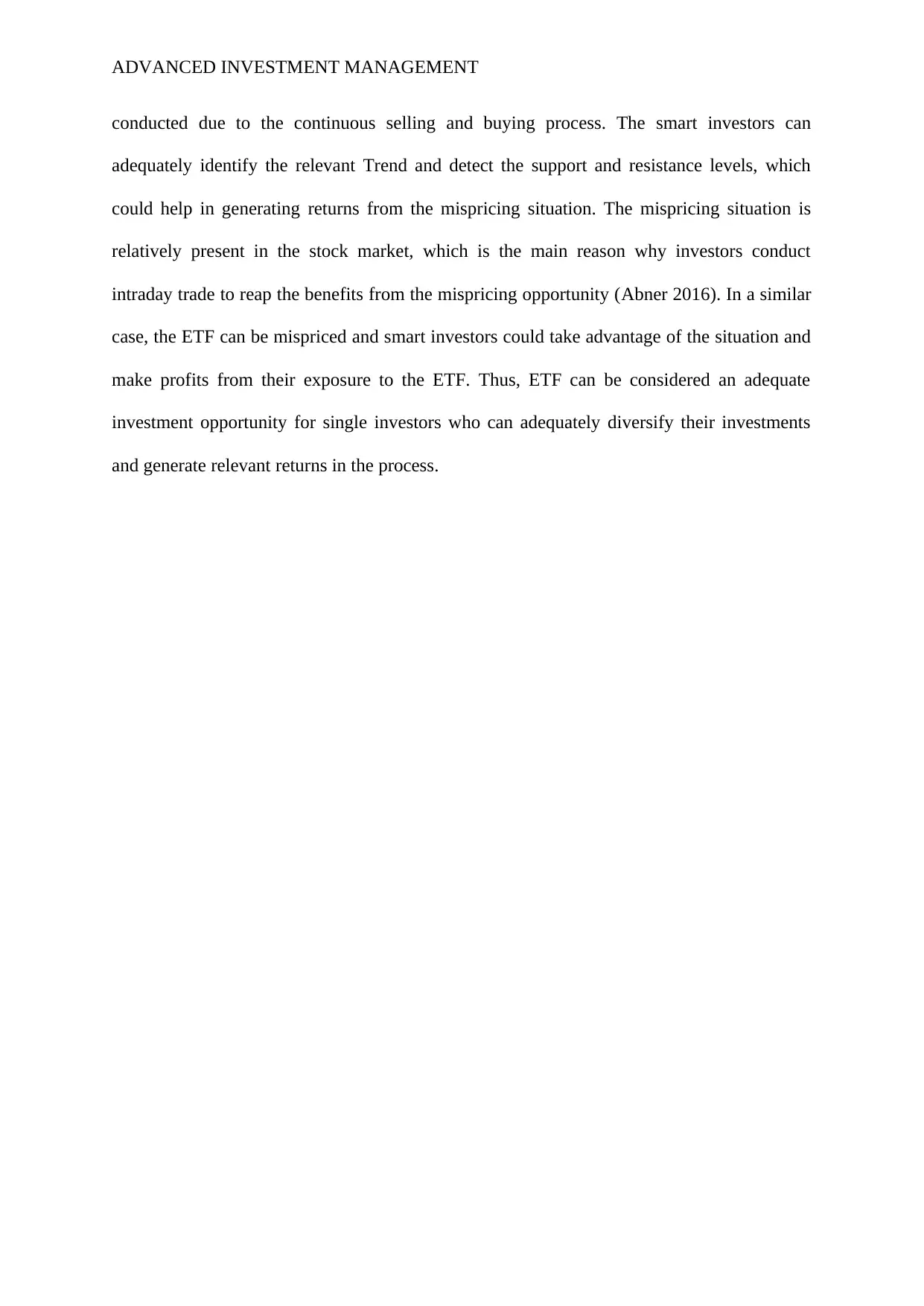
ADVANCED INVESTMENT MANAGEMENT
conducted due to the continuous selling and buying process. The smart investors can
adequately identify the relevant Trend and detect the support and resistance levels, which
could help in generating returns from the mispricing situation. The mispricing situation is
relatively present in the stock market, which is the main reason why investors conduct
intraday trade to reap the benefits from the mispricing opportunity (Abner 2016). In a similar
case, the ETF can be mispriced and smart investors could take advantage of the situation and
make profits from their exposure to the ETF. Thus, ETF can be considered an adequate
investment opportunity for single investors who can adequately diversify their investments
and generate relevant returns in the process.
conducted due to the continuous selling and buying process. The smart investors can
adequately identify the relevant Trend and detect the support and resistance levels, which
could help in generating returns from the mispricing situation. The mispricing situation is
relatively present in the stock market, which is the main reason why investors conduct
intraday trade to reap the benefits from the mispricing opportunity (Abner 2016). In a similar
case, the ETF can be mispriced and smart investors could take advantage of the situation and
make profits from their exposure to the ETF. Thus, ETF can be considered an adequate
investment opportunity for single investors who can adequately diversify their investments
and generate relevant returns in the process.
⊘ This is a preview!⊘
Do you want full access?
Subscribe today to unlock all pages.

Trusted by 1+ million students worldwide
1 out of 13
Your All-in-One AI-Powered Toolkit for Academic Success.
+13062052269
info@desklib.com
Available 24*7 on WhatsApp / Email
![[object Object]](/_next/static/media/star-bottom.7253800d.svg)
Unlock your academic potential
Copyright © 2020–2025 A2Z Services. All Rights Reserved. Developed and managed by ZUCOL.